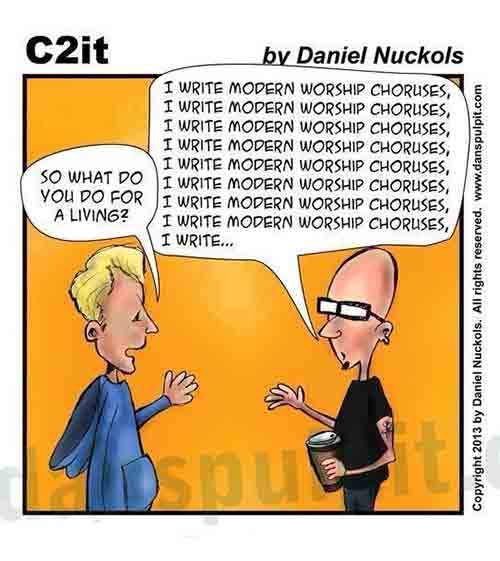I keep stumbling over articles that are concerned that Christian congregational singing is at a low ebb (eg. here, here, and here).
Elements that keep coming up:
- Concertisation of services. The congregation as spectators. Sanctuary has become a stage.
- Professionalisation of the band. The band is less a music group with a ministry of encouraging and leading singing, and more a professional-like band producing music of such quality that mere mortals don’t dare to spoil. For some people in the congregation lip syncing is in.
It is comparable to the Medieval period when those in the congregation were spectators of the professional choir of monks in the chancel. - The songs are not known. With the printing press, and improved general literacy, hymn books enabled all to sing with, say, a hundred or so well-known tunes. Overhead projectors at first merely replaced hymn books. Then there was a period when new songs were put up and introduced and taught before the service. Now, in many places, the pre-service song teaching has gone.
- The music is too loud. Why sing when my singing does not “add” anything? When I cannot hear myself sing? When I cannot even hear if I am in tune? When I cannot hear my neighbour singing – so there is no sense of all doing this together?
According to these posts and articles, the loss of congregational singing is especially noticeable in the loss of men singing.
Another element mentioned is the insipid theology and cheesy lyrics. I shared this image on facebook:
I loved the response:
Oh, come on guys; this is so inaccurate.
Let’s at least acknowledge how they would REALLY sound:Modern
Modern Worship
Modern Worship Choruses:
I write them,
I write only for You. x4I bring my Modern Worship Choruses
Choruses, Choruses for You.
I bring my Modern Worship Choruses
Choruses, Choruses for You.
I bring my Modern Worship Choruses
Choruses, Choruses for You.I adore – for You.
Not abhor – for You.
They’re in store
For You. x2For You
For You
For You
For You





Yeah, a real problem i agree, concertisation does seem to be the thing, co-incidentally paralleling the worlds way of gathering (trying to compete wit the wordl)
For me as a priest, the issue is orchestra worship of our too wonderful and majestic for words God with congregational performance unto God or one instrument (more or less; loud drums, guitars etc) with an audience.
ALL i want to have happen, is the very very best quality worship we can offer as a token of our thanks and honouring of God. Anything less is to use an old kiwi phrase pi.. poor 🙁 and often sloopy and falls way way short of exhilarating worship with all of our, heart, mind, body and soul.
I am tired of going to churches that haven’t a clue of what they are capable of offering and really at the too close minded to be open to discussion.
I hope God isn’t disappointed with their efforts or more importantly mine! 🙂
YUP — and the other factor is Endemic Illiteracy = can’t read the words fast enough to sing. I was with a group of seniors (chiefly) the other night; in another life, I was with much the same group of people when hymns were to be sung, and I heard their complaints of “we can’t sing”. But they could all sing “A Long Way to Tipperary,” as they proved, and “Bless’em All,” so what does that say? Either that our hymn-writers should consider those tunes — or we do need at least a warm-up before the liturgy begins.
I lament the lack of commitment to well-trained singers in the church. I love good music well done in praise whether a Bach Cantata in the service (a tradition at Boston) or a Mozart Mass (often in Innsbruck) or the great unaccompanied music of the 16th and 17th century (e.g. St Thomas Fifth Ave, the Byrd Great service). These are true acts of praise whether the individuals know it or not.
Bad hymn singing is not on and I have heard everything from the out of tune lone tenor leading unaccompanied in a Brethren assembly to Anglican noises with every voice pressing itself into oblivion.
Recently I heard a well constructed service around harp and flute music at Temple Emmanu-El on fifth ave in NYC – not exactly my style but well practiced and performed with jubilation as in Psalm 33 where the new song is first commanded (v3).
It is clear from the musical signs in the Hebrew that there was a considerable ability in the early Temple music. You can find many examples illustrated on my blog. Eg. http://meafar.blogspot.ca/2014/05/bereshit-in-beginning-of.html, the opening verse of Genesis explained here (that whole chapter beautifully sung by French soprano Esther Lemandier is available from you-tube).
Does God have good taste? I dreamed once that Jesus was about to conduct the St Matthew Passion but he stepped aside and handed the baton to Mr Bach – “You do it, Maestro” he said.
Hmmm. That video parody makes for an interesting comparison with Seven Sharp’s piece on Destiny Church the other night: http://tvnz.co.nz/seven-sharp/exclusive-look-inside-brian-tamaki-s-destiny-church-video-5988551
How awesome indeed!
I have recently joined the worship group in my church. I originally thought it was my unfamiliarity with the songs that was making it hard. I’ve since noticed that songs written by large overseas churches are written for professionally trained singers with a much wider vocal range than what I have. Either the verse is too low to sing easily or I can’t reach the high notes in the chorus.
On the other hand some hymns are challenging to sing well too.
lots of practice is called for, as with any other discipline.
Helpful, thoughtful comments, thanks Claudia. Christ is Risen!
The other situations I have heard of are (somewhat parodied):
“A congregation where they have found a couple of people who once had piano lessons, who now struggle through the music with no sense of timing for singing (too fast, more often too slow and sometimes altogether irregular). And play the same repertoire of “well known” hymns and songs from the 1950s through 1970s (but nothing later than 1979 thanks very much).”
and
“A congregation that has given up on ever finding or encouraging musicians, so everything is sung to low budget, cheesy, electronic backing tracks – or not at all”.
So ones that have worship bands are in a place of relative strength. The challenge for them is bringing the music back into the liturgy. Whereas I suspect a large number of congregations are struggling to have any singable music at all.
In terms of what helps, the most helpful thing I have found is having some good lead singers throughout the congregation who know the songs and can keep the song going. The least helpful thing is having a clergy or liturgist who can’t sing in time or tune sing more loudly to ‘rescue’ the song.
In the end, the only thing required is a joyful noise – and if there is no joy then something is amiss.
it’s the lyrics
it’s the lyrics that are the problem
cuddle me, cuddle me jesus
fluff my pillow
hold me tight
hold me oh so tight
thank you for saving Me Me me
I just want to praise you
here among all these people
just little ol me me me.
i need you, I want you, i can’t live without you
did i thank you for saving me?
Thank you for the cross
who needs meat,
when you can sing about the milk
sing about the milk
sing aboput the milk
over and over and over
Cos it really is
all about me Jesus
All about me Jesus
all about ME Jesus.
Sorry, button pushed!
It is the lyrics. They are repetitive and say very little, and the volume hurts our heads. Most praise songs sound very, very similar. It is so repetitive. Then, the dizzy projections on the wall look like an attempt to hypnotize. I realize styles change with each generation, but where is the richness and variety that God gives our creative minds?
Love your lyrics!!
One stregth of a choir is that it is a group of singers singing together, as opposed to a couple of soloists. I enjoy rock music, but it is essentially a soloist’s medium. As soon as you put a rock band in front of the congregation, you will risk focussing on just one or two singers, rather than on music coming from many voices.
Ironically whilst we look down our liturgical noises at repetitive choruses, we might sing aTaize chant repetitively. Whilst not advocating repetitive for the sake of repetitive, we should be careful not to dismiss it outright either. The key is explicit intentionality. I have no problem singing a chorus many times of I am scaffolded into understanding why, and as long as it is not done for every song every service, – again unless with intentionality.
So maybe some of our Hillsong are the modern equivalent of the chants of the past:
– Deliberately simple
– catchy tune
– essentially allowing us to sing them mindlessly, and thus slip into a state of prayerfulness.
Understanding the intent is important, and we gloss over it at our peril – especially given the appeal that the music has to many in younger generations.
Nicely put Jon. I was actually just thinking of deleting my whole comment above. t was more of an unloading with peop’s who understand, as I never get the opportunity to share the wider worship song world with the uninitiated of whom I and others are kinda despairing 🙂
So many faults, esp in “my” church, its just so hard to encounter the other cultural weaknesses that are so predominant whilst “our” churches are terminal if we are honest and discerning enough. Sigh, Poor God has a right bunch of kids, from snobs to mindless simpletons: eek, maybe their child likeness is what Jesus appreciates the most? 🙂
Thought I should add this:
A Funny Little Story About Hymns and Praise Songs
By Author Unknown
An old farmer went to the city one weekend and attended the big city church. He came home and his wife asked him how it was.
“Well,” said the farmer. “It was good. They did something different, however. They sang praise choruses instead of hymns.”
“Praise choruses?” asked the wife. “What are those?”
“Oh, they’re okay. They’re sort of like hymns, only different,” said the farmer.
“Well, what’s the difference?” asked the wife.
The farmer said, “Well it’s like this … If I were to say to you, ‘Martha, the cows are in the corn,’ well that would be a hymn. If, on the other hand, I were to say to you, ‘Martha, Martha, Martha, Oh, Martha, MARTHA, MARTHA, the cows, the big cows, the brown cows, the black cows, the white cows, the black and white cows, the COWS, COWS, COWS are in the corn, are in the corn, are in the corn, in the CORN, CORN, CORN, COOOOORRRRRNNNNN,’ then, if I were to repeat the whole thing two or three times, well that would be a praise chorus.”
As luck would have it, the exact same Sunday a young, new Christian from the city church attended the small town church. He came home and his wife asked him how it was.
“Well,” said the young man, “It was good. They did something different, however. They sang hymns instead of regular songs.”
“Hymns?” asked the wife. “What are those?”
“They’re okay. They’re sort of like regular songs, only different,” said the young man.
“Well, what’s the difference?” asked the wife.
The young man said, “Well it’s like this … If I were to say to you, ‘Martha, the cows are in the corn,’ well that would be a regular song. If on the other hand, I were to say to you,
Oh Martha, dear Martha, hear thou my cry
Inclinest thine ear to the words of my mouth.
Turn thou thy whole wondrous ear by and by
To the righteous, glorious truth.
For the way of the animals who can explain
There in their heads is no shadow of sense,
Hearkenest they in God’s sun or his rain
Unless from the mild, tempting corn they are fenced.
Yea those cows in glad bovine, rebellious delight,
Have broke free their shackles, their warm pens eschewed.
Then goaded by minions of darkness and night
They all my mild Chilliwack sweet corn chewed.
So look to that bright shining day by and by,
Where all foul corruptions of earth are reborn
Where no vicious animal makes my soul cry
And I no longer see those foul cows in the corn,
then, if I were to do only verses one, three and four, and change keys on the last verse, well that would be a hymn.”
Absolutely brilliant, Vicki! Thanks so much!
Exactly Vicki! We like what we like and fail to see the similarities in what we don’t, because we are so focused on the differences.
Excuse the digression, but many years ago when the Boney M song “By the Rivers of Babylon” came out, and all the time from then until I was at theological college in Melbourne, I thought the words were “how can we sting the Lord’s Song in Australia”.
For 25 years I wondered, whilst living there if I got it right anyway … but no.
More seriously, our hymns are a prayer prayed twice. The secret is do we want to offer these words twice to God, or will they send God to sleep with sheer tedium? Tunes of course, and instrumentation, can always be modernised. There are good contemporary words around, but on the whole “Jesus is really groovy and he makes me really happy times eight” probably makes the triune God reach for the Mogadon.
Recently we’ve got new hymn books at church – same hymns plus others. The layout of the music is one line of melody with words underneath. For some hymns the chorus is at the beginning; for others it follows the first verse and has to be referred back to after second and third verses, etc.
I usually sit near the back and have been able to observe how people use or are not using their books.
Because the selected hymns change each week, I suspect that only people who have learned to sight-read music at some time in the past are fully participating in the singing. The majority of people either don’t use the books at all, or attempt to pick up the words and melody as the hymn progresses. There is quite a large proportion of people in the congregation who probably have not had the benefit of learning singing at school.
The musical accompaniment is good – instruments vary according to the time of Mass; there is sometimes a small choir with good lead voices.
We have an overhead screen which is only used occasionally.
I keep saying to myself: Something is missing; what is it?
Any suggestions would be gratefully received.